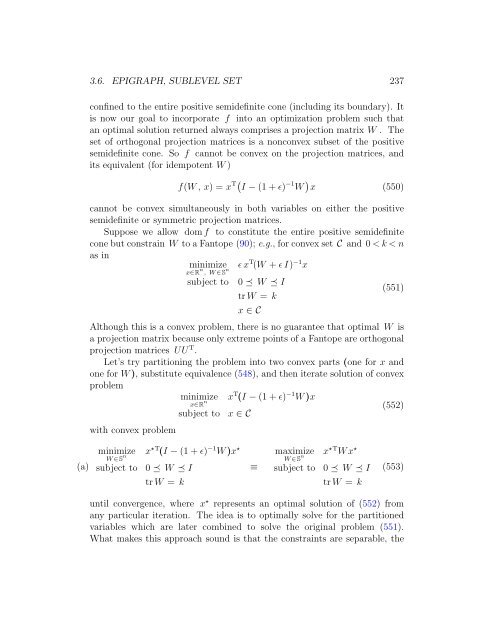Chapter 3 Geometry of convex functions - Meboo Publishing ...
Chapter 3 Geometry of convex functions - Meboo Publishing ...
Chapter 3 Geometry of convex functions - Meboo Publishing ...
You also want an ePaper? Increase the reach of your titles
YUMPU automatically turns print PDFs into web optimized ePapers that Google loves.
3.6. EPIGRAPH, SUBLEVEL SET 237<br />
confined to the entire positive semidefinite cone (including its boundary). It<br />
is now our goal to incorporate f into an optimization problem such that<br />
an optimal solution returned always comprises a projection matrix W . The<br />
set <strong>of</strong> orthogonal projection matrices is a non<strong>convex</strong> subset <strong>of</strong> the positive<br />
semidefinite cone. So f cannot be <strong>convex</strong> on the projection matrices, and<br />
its equivalent (for idempotent W )<br />
f(W , x) = x T( I − (1 + ǫ) −1 W ) x (550)<br />
cannot be <strong>convex</strong> simultaneously in both variables on either the positive<br />
semidefinite or symmetric projection matrices.<br />
Suppose we allow domf to constitute the entire positive semidefinite<br />
cone but constrain W to a Fantope (90); e.g., for <strong>convex</strong> set C and 0 < k < n<br />
as in<br />
minimize ǫx T (W + ǫI) −1 x<br />
x∈R n , W ∈S n<br />
subject to 0 ≼ W ≼ I<br />
(551)<br />
trW = k<br />
x ∈ C<br />
Although this is a <strong>convex</strong> problem, there is no guarantee that optimal W is<br />
a projection matrix because only extreme points <strong>of</strong> a Fantope are orthogonal<br />
projection matrices UU T .<br />
Let’s try partitioning the problem into two <strong>convex</strong> parts (one for x and<br />
one for W), substitute equivalence (548), and then iterate solution <strong>of</strong> <strong>convex</strong><br />
problem<br />
minimize x T (I − (1 + ǫ) −1 W)x<br />
x∈R n<br />
(552)<br />
subject to x ∈ C<br />
with <strong>convex</strong> problem<br />
(a)<br />
minimize x ⋆T (I − (1 + ǫ) −1 W)x ⋆<br />
W ∈S n<br />
subject to 0 ≼ W ≼ I<br />
trW = k<br />
≡<br />
maximize x ⋆T Wx ⋆<br />
W ∈S n<br />
subject to 0 ≼ W ≼ I<br />
trW = k<br />
(553)<br />
until convergence, where x ⋆ represents an optimal solution <strong>of</strong> (552) from<br />
any particular iteration. The idea is to optimally solve for the partitioned<br />
variables which are later combined to solve the original problem (551).<br />
What makes this approach sound is that the constraints are separable, the
















